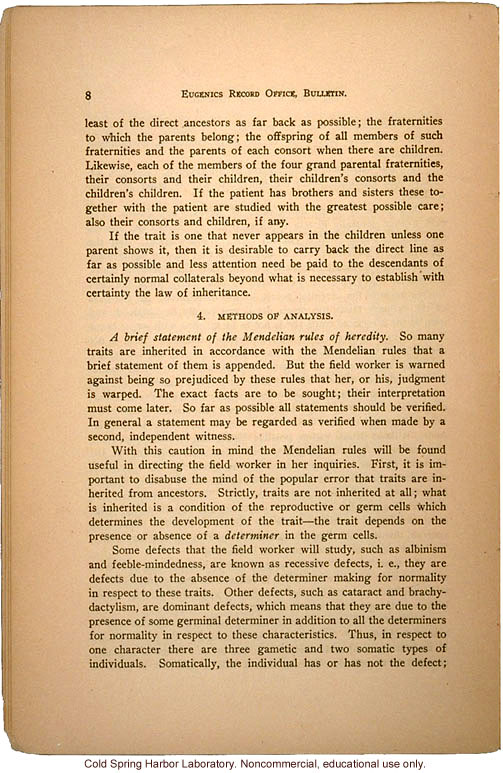"The Study of Human Heredity," by Davenport, Laughlin, Weeks, Johnstone, and Goddard, Eugenics Record Office Bulletin No. 2 (8)

"The Study of Human Heredity," by Davenport, Laughlin, Weeks, Johnstone, and Goddard, Eugenics Record Office Bulletin No. 2 (8)
1779. 8 Eugenics Record Office, Bulletin. least of the direct ancestors as far back as possible; the fraternities to which the parents belong; the offspring of all members of such fraternities and the parents of each consort when there are children. Likewise, each of the members of the four grand parental fraternities, their consorts and their children, their children's consorts and their children's children. If the patient has brothers and sisters these together with the patient are studied with the greatest possible care; also their consorts and children, if any. If the trait is one that never appears in the children unless one parent shows it, then it is desirable to carry back the direct line as far as possible and less attention need be paid to the descendants of certainly normal collaterals beyond what is necessary to establish with certainty the law of inheritance. 4. Methods of Analysis. [italics]A brief statement of the Mendelian laws of heredity.[end italics] So many traits are inherited in accordance with the Mendelian rules that a brief statement of them is appended. But the field worker is warned against being so prejudiced by these rules that her, or his, judgment is warped. The exact facts are to be sought; their interpretation must come later. So far as possible all statements should be verified. In general a statement may be regarded as verified when made by a second, independent witness. With this caution in mind the Mendelian rules will be found useful in directing the field worker in her inquiries. First, it is important to disabuse the mind of the popular error that traits are inherited from ancestors. Strictly, traits are not inherited at all; what is inherited is a condition of the reproductive or germ cells which determines the development of the trait - the trait depends on the presence or absence of a [italics]determiner[end italics] in the germ cells. Some defects that a field worker will study, such as albinism and feeble-mindedness, are known as recessive defects, i.e., they are defects due to the absence of the determiner making for normality in respect to these traits. Other defects, such as cataract and brachydactylism, are dominant defects, which means that they are due to the presence of some germinal determiner in addition to all the determiners for normality in respect to these characteristics. Thus, in respect to one character there are three gametic and two somatic types of individuals. Somatically, the individual has or has not the defect; [end]
- ID: 11694
- Source: DNALC.EA


